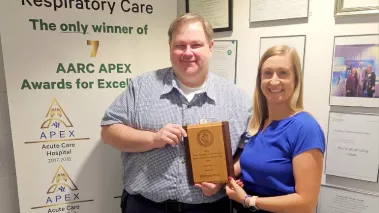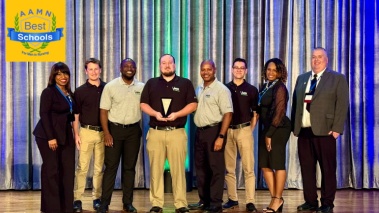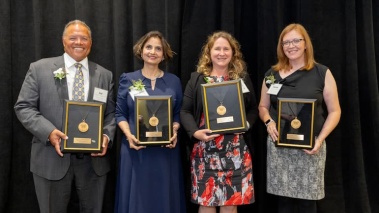As a fourth-year interventional radiology resident, Maria Kotarska, MD, would normally be navigating a grueling schedule filled with complex vascular and imaging cases and rigorous on-the-job training. Instead, she’s getting a once-in-a-lifetime education working on the front lines of the COVID-19 pandemic.
Kotarksa, like many of the 750 residents and fellows at Rush, is being redirected from her typical residency routine and thrust into staffing one of three main areas treating the pandemic: the emergency department, hospital medicine and the intensive care unit. Based on their previous training, residents are deployed to units where they have an opportunity to contribute, even if those areas may seem like a far cry from their specialty.
According to the Accreditation Council for Graduate Medical Education (ACGME), 2,872 (42%) residents and fellows in Illinois, including the ones from Rush, were in ACGME-accredited sponsoring institutions that had declared a pandemic emergency status as of April 14. Nationally, 48,099 (33%) residents and fellows are in sponsoring institutions with this status.
“A fourth-year orthopedic surgery resident may be doing the work of a first-year intern in the ICU,” says Joy Sclamberg, MD, associate dean of Graduate Medical Education at Rush Medical College. “It’s anxiety-producing because they want to contribute but are all of a sudden working in areas outside of their primary focus.”
“Like the other residents, I was nervous about what to expect and what would be expected of me,” says Kotarska.
In order to temper some of that anxiety, Rush is making sure enough faculty and attending physicians are also staffed to back up residents should questions or unforeseen problems arise. Rush is also managing the workload by treating patients with a coterie of residents from different disciplines and managing the patient case load so residents don’t feel overwhelmed.
Residents can also draw upon on the rigorous training they’ve received where they have already been asked to adapt to take care of critically ill patients.
Surgical and anesthesia residents, for example, have already had years of experience managing critically ill postoperative patients, which makes them a great fit for the critical care setting. An interventional radiologist, such as Kotarska, has experience putting in lines, which also makes her an ideal fit in the ICU.
“They’ve been logging 60-70 hours per week for the last several years, so their skills and stamina are ready for this challenge,” says Phillip LoSavio, MD, assistant dean for Graduate Medical Education at Rush Medical College. “Everyone has been stepping up and working in roles to help the team function the best.”
An unintended benefit of these placements is creating teams of residents who wouldn’t have had the chance to work together. As Kotarska explained, in her usual rotations the majority of the residents also work in her specialty. In her first week in the ICU, however, her team consisted of orthopedic, general surgery, and anesthesia residents, and herself (an interventional radiology resident), plus nephrology and cardiology fellows, respiratory therapists, pharmacy and nursing staff.
“It was an incredibly unique learning environment,” she says. “Never have I’ve been part of such a strong, hardworking team where we all learned from one another.”
Kotarksa had concerns prior to starting her first week in the ICU about getting proper personal protective equipment (PPE). She’s followed the national storylines about undersupplied hospitals and, like anyone working on the front lines of the pandemic, was concerned about becoming ill on the job.
“I had no issues with PPEs — they were always available,” she says. “Our team checked one another before doing a procedure or going into a patient room.”
Sclamberg adds, “With residents’ anxiety around treatment of infected patients, we wanted to be transparent that we were in full stock of PPEs. We wanted them to feel heard and supported.”
“This is a time the residents will remember for decades to come,” says LoSavio. “They rose to the challenge and I’m incredibly proud of what they’ve accomplished. They inspire me in my job.”
Once Kotarksa overcame her initial worries, she too was inspired by the tireless work ethic, focus and teamwork exhibited by her colleagues.
“The minute I start working, I forget all about my fears,” she says. “It is unbelievably rewarding to be with a team that does whatever it takes to help take care of patients. This experience has reminded me of why I became a doctor, and it has the chance to define us for the rest of our lives and careers.”







